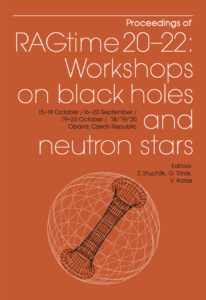
Published in December 2020 in Opava
Download version for print
Download online version
Z. Stuchlík, G. Török and V. Karas, editors
RAGtime – the series of the Relativistic Astrophysics Group workshops and proceedings – which started in 1999 at Institute of Physics in Opava, the Institute of Physics in Opava of the Silesian University in Opava, Czech Republic, has become after two decades of its existence a well-established and respected meeting with a strong tradition mainly devoted to relativistic astrophysics, but recently expanding also to some additional areas related to the relativistic and more generally also theoretical physics. This volume presents an edi- tion of the workshop proceedings associated with a triad of annual events organised during the years 2018, 2019, and 2020. The progress of research at this period has been rather outstanding. Just after the celebrations of the Centenary of the Einstein’s General Theory of Relativity and, it demonstrates spectacular achievements in both theory and related ob- servations, this time concentrated on direct observations of the closest neighbourhood of the black hole event horizon in the large observational projects such as the Event Horizon Telescope and GRAVITY, which in a fascinating way confirm the theoretical predictions in the area of the strongest gravity effects. Naturally, there are a number of additional, very important achievements in the area of both theory and observations, which confirm the expectations based on general relativity, and sometimes further challenge the research at the borderline of the modern theoretical physics, astrophysics, and particle physics. It is a great pleasure to say that the present edition of proceeding papers brings a significant contribution to most up-to-date research activities carried out in these fields.
The present volume is focused on the processes taking place in strong gravitational and electromagnetic fields in the vicinity of black holes and neutron stars, or various types of even more exotic compact objects. The solutions of general relativity are extended to viable alternatives, such as string theories and supersymmetry, or to the cases combining general relativity with possible variants of non-linear electrodynamics that are able to pre- dict the so-called regular black holes, which do not contain a central physical singularity. The astrophysical processes are treated in the test-particle or fluid-configuration approxi- mations. One of the central points are the observable optical phenomena and their most relevant demonstrations, namely the high-frequency quasi-periodic oscillations observed in the low-mass X-ray binaries containing accreting black holes or neutron stars, or in the case of supermassive black holes in active galactic nuclei, and furthermore also optical phenomena connected to the appearance of the spectroscopy and polarimetry of the emerg- ing radiation signal. Special attention has been devoted to complex structures of corotating and counterrotating fluid tori around supermassive rotating black holes. Important studies are related to the acceleration ultra-high energy cosmic rays, or to the relation of chaos and regularity in the motion of matter in gravo-magnetic fields around black holes. The equilibrium of charged fluid tori has been investigated within the analytical and numerical frameworks in situations related to the magnetized compact objects. Black holes have been considered in the context of cosmology and neutron stars in the context of hybrid config- urations combining the neutron and quark matter, or in the context of a charged fluid. In addition to the standard variety of works in the field of relativistic physics, this proceed- ings also includes a study relating the ideas of the so-called soliton solutions as applied to quantum informatics and to molecules relevant for the replications of DNA.
Most of the presented contributions have been obtained thanks to the collaboration of the research groups at the Silesian University in Opava, the Astronomical Institute of the Czech Academy of Science, the Faculty of Mathematics and Physics of the Charles University in Prague, and furthermore our colleagues at many other foreign institutions. The RAGtime participants from a wide international community have represented Observatoire de Paris, The Joint Institute for Nuclear Research in Dubna, The International Space Science In- stitute in Bern, Osservatorio Astronomico di Roma, University of Cologne, University of Oxford, The Ulugh Beg Astronomical Institute in Tashkent and others.
We thank the Editorial Board members for their valuable advice and assistance, and all the authors for the careful preparation of their contributions. We are also indebted to the Ministry of Education of the Czech Republic and the European Social Fund in the Czech Republic for providing the financial support for the workshops and participants’ activi- ties, namely within the INTER-EXCELLENCE project No. LTI17018, the ESF projects No.CZ.02.2.69/0.0/0.0/18 058/0010238, CZ.02.2.69/0.0/0.0/18 056/0013364, CZ.02.2.69/0.0/0.0/18 054/0014696, and the internal grants of the Silesian University in Opava No. SGS/13,14/2019 and IP/15/19.
Opava, December 2020
Z. Stuchlík, G. Török and V. Karas, editors
Editorial board:
Editorial assistants:
Mgr. Debora Lančová, Mgr. Monika Matuszková, Bc. Zuzana Turoňová, Ing. Jana Malkrabová
In this Proceedings, the talks presented during workshops RAGtime 20–22: Workshops on black holes and neutron stars, 15–19 Oct., 16–20 Sept., 19–23 Oct. 2018/2019/2020, Opava, Czech Republic are collected.
Copyright © 2020 Silesian University in Opava
Title:
Proceedings of RAGtime 20–22: Workshops on black holes and neutron stars, 15–19 Oct., 16–20 Sept., 19–23 Oct. 2018/2019/2020, Opava, Czech Republic
Published by:
Silesian University in Opava, Institute of Physics in Opava, Bezručovo nám. 13, CZ-746 01 Opava, Czech Republic
Editors:
Z. Stuchlík, G. Török and V. Karas
Cover design:
Otakar Karlas
© Institute of Physics in Opava, Silesian University in Opava, 2020
All rights reserved. No part of this publication may be reproduced, stored in a retrieval system or transmitted in any form or by any means, electronic, mechanical, photocopying, recording or otherwise, without the prior permission of the Publisher.
1st edition
Printed by:
Profi-tisk group s.r.o, Olomouc, Kyselovská 559/125, 783 01 Olomouc – Slavonín, Czech Republic
Published in December 2020

The publication was supported by the INTER-EXCELLENCE project No. LTI17018 and the internal grant of the Silesian University in Opava No. 07/2015-FPF.
ISBN 978-80-7510-433-5 (online)
ISBN 978-80-7510-432-8 (print)
ISSN 2336-5676 (online)
ISSN 2336-5668 (print)
Typeset in LATEX